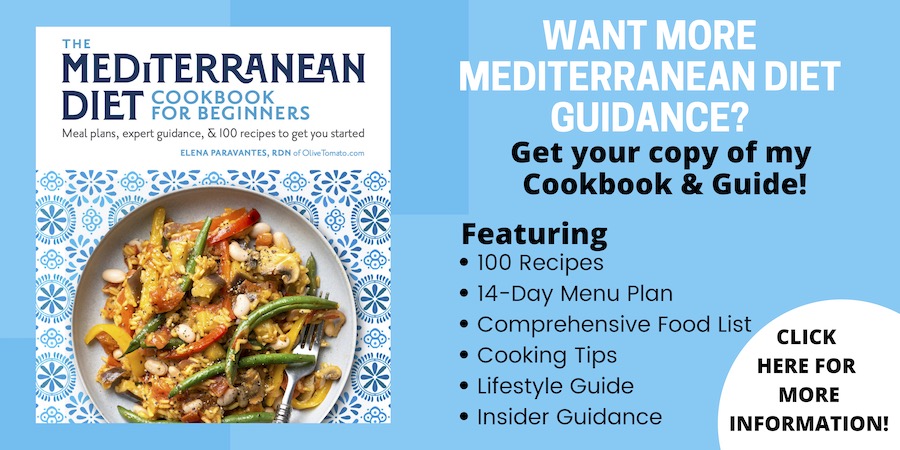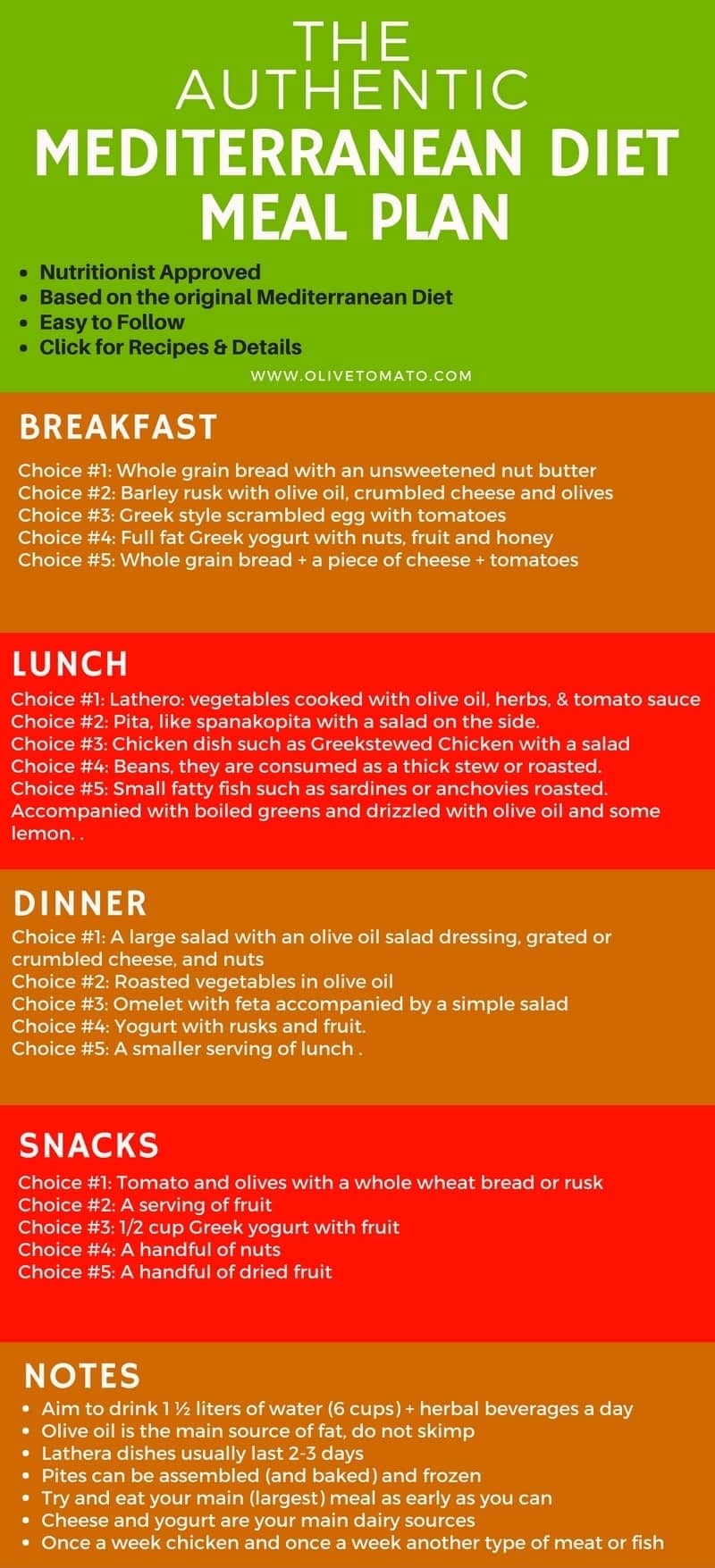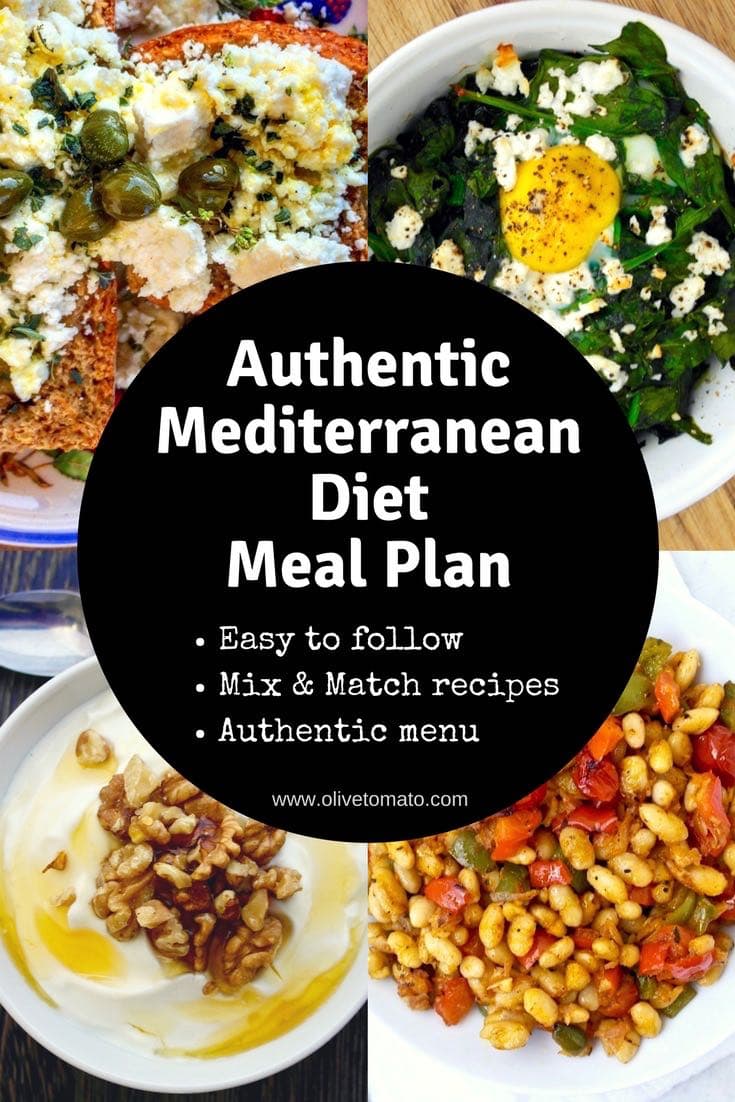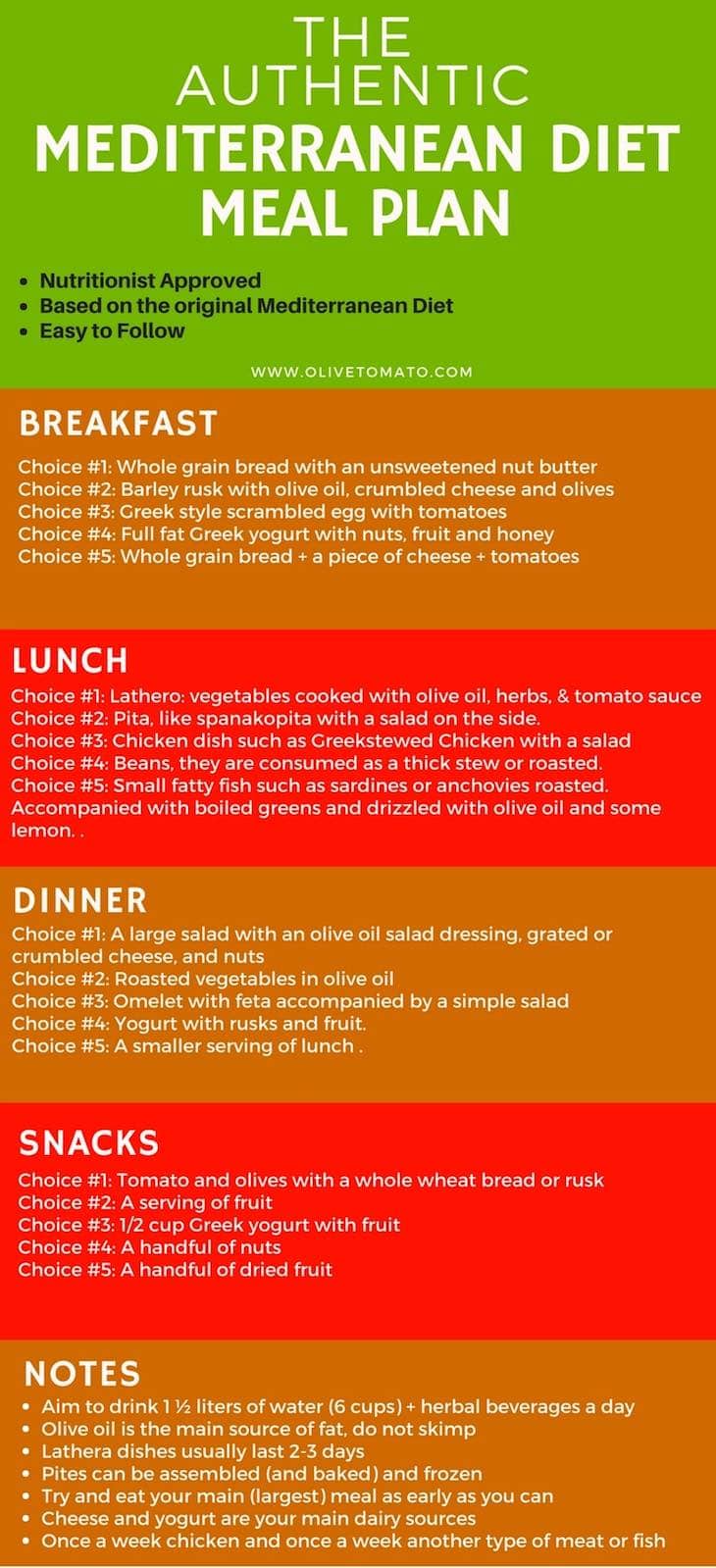The Mediterranean Diet Meal Plan
With this easy guide, you will get an easy to follow authentic Mediterranean diet meal plan with everything you need to get started: recipes and tips.
By Elena Paravantes, RDN, Registered Dietitian Nutritionist, Mediterranean Diet Expert
I’ve been asked many times to provide an authentic Mediterranean Diet meal plan, and when we say authentic, we mean it! The reason for this is that most “Mediterranean Diet” meal plans I see online are anything but. Sorry, but edamame beans, minuscule amounts of olive oil, canola oil, meat with every meal etc. are not part of a Mediterranean Diet.
The Mediterranean Diet is considered the Gold Standard of diets. It was voted Best Diet for 7 years in a row from US News and is associated with numerous health benefits supported by strong evidence. This covers heart Health, Cancer Prevention, Psychological Health, Alzheimers, Fertility, Weight Loss and many more.
Now I have to say, I am not a supporter of rigid plans, however it is important to eat at somewhat regular times so you don’t end up feeling very-very hungry at any particularly moment of the day. Having said that, I also think it is important to be able to actually feel hunger, and look forward to eating a meal. While adding a snack here and there is good to keep blood sugar and hunger levels in balance, snacking can also backfire. Many times we eat a snack without being hungry or we depend on ready-made snacks such as granola bars, juices, smoothies etc. which not only add quite a few calories but also are a processed food with all that entails.
Below is a quick graphic of a meal plan on the traditional Mediterranean diet, it is the same meal plan that I also follow. Under the graphic you can find details, tips and links to the recipes. I provide a variety of choices for meals that you can mix and match with links to the recipes. For more ideas just head over to the Recipe Index and you will find a large selection of Mediterranean recipes.
Enjoy!
The Authentic Mediterranean Diet Meal Plan
Details, Tips And Recipes
-Breakfast-
Coffee
+
Choice #1: Whole grain bread with an unsweetened nut butter (I use tahini)
Choice #2: Barley rusk with olive oil, crumbled cheese and olives
Choice #3: Greek style scrambled egg with tomatoes (Kagianas) or other egg dishes with veggies. Click for egg recipes.
Choice #4: Full fat Greek yogurt with nuts, fruit and honey
Choice #5: Whole grain bread + a piece of cheese + tomatoes
-Mid-Morning Snack-
*A seasonal fruit
-Lunch-
Lunch in the largest meal of the day. If you have trouble doing that, you can switch dinner with lunch and try and have dinner somewhat early.
Choice #1: Lathero Dish (seasonal vegetables or beans cooked with olive oil, herbs, and tomato sauce accompanied by bread and cheese). This is what you will have 3-4 times a week. Typically this is green beans, peas, spanakorizo (spinach-rice) and cauliflower cooked in this way. This is accompanied by a slice of bread and feta. Click for lathera recipes. Please note that one serving consists of 3-4 servings of vegetables.
Choice #2: Pita like spanakopita with a salad on the side. Check our pita recipes.
Choice #3: Once or twice a week a chicken dish such as Greek style stewed chicken with a seasonal salad
Choice #4: A bean dish. Beans such as lentils as well as white beans are consumed as a thick stew or roasted. They are accompanied with feta cheese and some bread.
Choice #5: Small fatty fish such as sardines or anchovies roasted. Accompanied with lightly boiled greens and drizzled with olive oil and some lemon.
1 fruit
-Snack- (if hungry)
*Tomato with a rusk and sometimes cheese + a serving of fruit
or
*1/2 cup Greek yogurt with fruit
-Dinner-
Dinner is a lighter meal, so it is generally good to keep fairly light-avoid meats and heavy sauces. Typically it is a small serving of lunch or a meal rich in vegetables.
Wine (1 – 1 ½ glass) and a small meze platter (2-3 olives, a few pieces of cheese, tomato or carrot sticks)
AND
Choice #1: A smaller serving of lunch
Choice #2: A large salad (in the winter mainly greens, in the summer tomatoes) with an olive oil salad dressing, grated or crumbled cheese, and nuts (walnuts, pine nuts or almonds). Check our Mediterranean salad recipes.
Choice 3: Roasted vegetables in olive oil (cauliflower or a mix –like briami). This is an easy and effortless way to get prepare vegetables and consume it as a main course.
Choice 4: Omelette with feta accompanied by a simple salad such as tomato and cucumber with olive oil or a green leafy salad.
Choice #5: Yogurt with rusks and fruit. This is a typical evening meal, particularly if lunch has been a bit larger.
*Once a week chicken and once a week another type of meat or fish, accompanied by salad or greens (horta)
*One or two meals a week contain some sort of pasta.

Notes:
- Beverages: Aim to drink 1 ½ liters of water (6 cups) + herbal beverages a day. Avoid any other beverages except wine.
- Olive oil is the main source of fat, do not skimp. Benefits are seen at a consumption of at least 2 tablespoons a day. Olive oil also provides satiety (among many other benefits) which is important if you are eating a meal made only with vegetables.
- Lathera dishes usually last 2-3 days (in fact they taste better the next day). I also use frozen peas or green beans in the winter for my lathera.
- Pites can be assembled (and baked) and frozen.
- Try and eat your main (largest) meal as early as you can.
- Cheese and yogurt are your main dairy sources.
- Finally, this is meant meant to be a guide, as each person’s (calorie) needs varies depending on age, gender, physical activity level etc. However, I advise you check the Greek Nutrition Guidelines which basically represents the Mediterranean diet that includes a range of servings. Go here to check the Greek Diet guidelines.
And don’t forget to check the complete Mediterranean diet shopping list here:
FIRST TIME VISITING?
Welcome! You have arrived to the most credible source for the Real Mediterranean Diet. If you are looking for tried and trusted information, you’re at the right place! Learn more about olivetomato browse all our recipes or check our Mediterranean Diet resources. Subscribe for free for more Mediterranean recipes, tips and guidance.

Images by Elena Paravantes © All Rights Reserved



This template, in addition to your book, have been godsends when it comes to planning my meals!!! It takes away all the stress that I used to get when trying to decide what and how to feed myself and family!
Also, I really appreciate the easy and delicious recipes. ❤️ I do follow a couple of other “Mediterranean diet” bloggers/sites and I always land back here for the simplicity in prep, ingredients and cook time…not to mention the amazing flavor!!! It’s like magic and I’m amazed every time!
I would love to see another cookbook (again with more of your helpful meal plan templates), Elena. ❤️
Thank YOU for all you do!
Hi Elana
Dr suggested the Mediterranean diet, got your book looks awesome. We’re planning to do the two week starter for beginners. Is there a printable of the two week? Also a shopping list geared towards the two week? I found the overall list but wanted to get some cheater help on the implementation:). Thanks for all your efforts to help us unhealthy eaters that love food!
Wayland
Hi Elena,
Do the Greeks eat oatmeal.
Finally! A sample diet I can follow. Thank you
. So I just ordered your book. Myself & my husband both have some health issues that need to be managed by changing our diets and lifestyle: My only concern is breakfast==I tend to enjoy savory foods 24/7 but my husband is a total baby bout his cereal even so called “healthy” cereal and while the yogurt with honey suggestion sounds perfect for him, I know if I keep a jar of honey in the house, I will wake up to a trail of honey and him in a sugar coma in the kitchen. I wish I was joking, but I recently got angry at family who gifted him a giant jar.Anyway, any other breakfast suggestions for those who are physically and emotionally addicted to sugar in all its forms? Even just something to transition him to a new breakfast, that is also very simple. Me, I am easy. I lived in Israel and ate a very similar diet, and I love all the foods and veggies. etc, he is gong to be a challenge, but I don’t want him to die, or lose a leg or anything.
Hello!
I work nightshift about 5 days a week. I can schedule my eating habits around a day time schedule but then I’m working a 12hr shift and end up starving by morning time. Any suggestions on how best to schedule eating times for a nightshifter?
How large should a cooked serving of a grain, such as farro, be? I’m afraid I might be overdoing.
Hi Elena. I have just purchased your book and I can’t wait to try your recipes. I like having oatmeal for breakfast. Is this permitted on the Mediterranean diet?
Hi I was wondering that myself but as there’s option for whole grain bread, I reckon it’s ok. I love my steel cut oat porridge with blueberries in the mornings, just a small serving, so I skip the bread at breakfast time and have my oats .
Hello,
I’ve been cooking your recipes for a long time and recently purchased you book.
Question:- how can I get all the daily calcium I need? I live in uk and recommended daily amount is 700mg.
With best wishes,
Jane
Thank you Jane! Yes on average you will be getting your recommended amount of calcium when following a balanced Mediterranean diet which includes 2-3 servings of dairy (mainly in the form of yogurt and cheese) but also non-dairy foods that are rich in calcium such as nuts, greens, beans (legumes, and small fish, these are also good sources of calcium. Studies have shown that the Mediterranean diet is associated with lower risk of osteoporosis and hip fractures.
You don’t have any soups in your cookbook or in this meal plan. Maybe it’s because everyone already knows how to make soup. But surely basic veggie (without cream), bean/lentil or a basic homemade chicken soup could serve as one of the meals?
Hi Joanne! We do have stews in the cookbook: there is lentil stew, pasta e fagioli, Mediterranean black-eyed bean stew, sweet potato and chickpea moroccan stew. Hearty bean based stews are great for a main course.
We have checked your account. It appears that emails to your inbox are bouncing, particularly to you. We have re-added you but you need to contact your service provider as the issue will continue.
Thank you
My first time doing the Mediterranean diet hopefully I can stick to it for great results. Thank you for your information everything looks delicious
Thank you for your recipes – we just bought your cookbook and have loved the 2 recipes that we’ve made.
2 questions – cooked tomatoes are too acidic for me (acid reflux). For the dishes requiring a tomato sauce or base, can you recommend a substitute that would also be flavorful?
Also, just double checking that it is OK to mix and match recipes for any given day with recipes from a different day?
Thank you.
Hi! Hope you are enjoying the book! For the tomato sauce, in some recipes you can omit it (it will affect the taste though) or you can try using a bit of tomato paste to give it a touch of tomato flavor. Also I find that cooking it at very low heat helps, just a simmer.
You can substitute some recipes for others that are similar in terms of the type of dish (vegetables, meat, etc.).
Thank you, Ellen. Great suggestion about using tomato paste.
Final question – how do you ‘grate’ a tomato?!? I may have missed something in reading your book but have not a clue re: how to grate a tomato. I am currently looking at the on-line recipe for the Cretan Salad.
And, your book is really beautiful and easy to follow. I am trying lower my blood pressure as well and am looking forward to completely diving in to this style of eating.
Thank you for helping us find our way back to health.
Hi JJ, I have the dakos recipe in the book where I provide instructions on how to grate a tomato, adding it here too: Slice a thin round off the bottom of the tomato, holding the tomato by the stem side, start grating the tomato at the cut side, using the largest holes of the grater. Grate over a plate until you reach the skin of the tomato (you should be left with the flattened skin). Throw away the skin, drain the liquids using a fine mesh strainer and set aside.
Hello I’m just a beginner and was curious about the Mediterranean plan due to the fact that several dishes call for tomatoes…… soooo Thanks for the advice as well & now I can continue. Thanks to the one that asked the question.
You can buy or grow acid-free tomatoes
I’m officially addicted to your website. As an Orthodox Christian in South Africa, I tend to struggle with the Lenten seasons because I cannot fit them into my “low carb” attempts. With this way of eating, I don’t need to switch between diets.
I’ve printed the meal plans for inspiration.
Thank you for your kind words Zee! Happy to provide helpful information.